Joaquin Torres Garcia Nuevo Arte De Las Americas 1942
| Joaquín Torres García | |
|---|---|
 Torres-García at the Sagrada Família in Barcelona in 1903 | |
| Born | Joaquín Torres Garcia (1874-07-28)28 July 1874 Montevideo, Uruguay |
| Died | 8 August 1949(1949-08-08) (anile 75) Montevideo, Uruguay |
| Nationality | Uruguayan, Spanish |
| Education | Escuela Oficial de Bellas Artes Barcelona |
| Known for | Painting, sculpture, writing, teaching, illustration |
| Movement | Modern art, noucentisme, constructivism |
| Website | https://jtorresgarcia.com/ |
Joaquín Torres García (28 July 1874 – viii August 1949) was a Uruguayan-Spanish artist[1] who was born in Montevideo, Uruguay. Torres-García emigrated to Catalunya, Kingdom of spain equally an boyish, where he began his career every bit an artist in 1891. For the next three decades, Torres-García embraced the Catalan identity and led the cultural scene in Barcelona and Europe. Equally a painter, sculptor, muralist, novelist, writer, teacher, and theorist, Torres-García was considered a "renaissance" or "universal man." He used a simple metaphor to deal with eternal struggles he faced between the old and the new, between classical and avant-garde, between reason and feeling, and between figuration and brainchild: there is no contradiction or incompatibility. Like Goethe, Torres-García sought to integrate classicism and modernity.[2] Although he lived and worked primarily in Espana, Torres-García was also agile in the Us, Italy, French republic, and Uruguay; he influenced European and North American and S American modern art.

Torres-García is known for his 1903 collaboration with Antoni Gaudí on the stained-glass windows for the Palma Cathedral[3] and the Sagrada Família.[4] He decorated the medieval Palau de la Generalitat de Catalunya with awe-inspiring frescoes.[5] His art is associated with primitive universal civilisation, including Mediterranean cultural traditions, Noucentisme, and modern classicism. Torres-García developed a unique style (first known as "Fine art Constructif") during the 1930s, while he lived in Paris. Arte Constructivo (Constructive Art), a schoolhouse he opened in Madrid, became Universalismo Constructivo (Universal Constructivism, a treatise he published in South America while teaching in his workshops Asociación de Arte Constructivo and El Taller Torres-García). Torres-García's art combines classical and archaic traditions with twentieth-century "-isms": Cubism, Dada, neo-plasticism, primitivism, surrealism, and abstraction.
Torres-García published over 150 books, essays and manufactures in Catalan, Spanish, French and English, and delivered more than 500 lectures. He founded several art schools in Spain and Montevideo and a number of artistic groups, including the first European abstruse-art group. Torres-García founded the mag Cercle et Carré (Circle and Square) in Paris in 1929.
Retrospectives in Paris (1955) and Amsterdam (1961) are the primeval shows documenting Torres-García in the world of abstract fine art. In the U.s.a., he exhibited in New York during the 1920s as the Whitney Studio Club, the Lodge of Independent Artists and the Societe Anonyme were emerging. In the 1930s, Albert Eugene Gallatin exhibited Torres-García's piece of work in the Museum of Living Art with modern masters Picasso, Georges Braque, Henri Matisse and Fernand Léger. The Museum of Modern Fine art opened its Latin American collection in the 1940s with the acquisition of Torres-García's work, and the Sidney Janis and Rose Fried galleries sponsored shows during the 1950s. The Solomon R. Guggenheim Museum had a retrospective exhibition in the 1970s, and more than-recent retrospectives at the Museum of Modern Art (2015) and the Acquavella Galleries (2018) exhibited Torres-García'south art with a contemporary perspective.
Life [edit]
1874–1900 [edit]
Torres-García was born on 28 July 1874 in Montevideo, Uruguay, a port city surrounded by the South American Pampas. He was the get-go kid of Joaquim Torras Fradera (an emigrant from Mataró, Espana) and María García Pérez. Torres-García grew up in the Almacen de Joaquín Torres, his father's general store.[6] Every bit a child, he "examined the picturesque store situated in the sometime Square of the Wagons, the arrival point of the raw cloth of the land for export to Europe. The colonial Montevideo had a port, trains, and a vibrant population dotted with countless gauchos wrapped in capes with whip ready in hand."[7] "Much of his early education in that predominantly agricultural society came from his ascertainment of the things effectually him ... He received his first formal art training when his family returned to Spain."[viii]
Torres-García'southward father, frustrated with a century of civil wars, returned to his homeland with his family in 1891; they became Spanish citizens.[1] Torres-García studied with a local painter, and soon showed an aptitude for art. When the family moved to Barcelona, he enrolled in the School of Fine Arts in Barcelona (Escuela de Bellas Artes de Barcelona), the Baixas Academy (Academia Baixas) and the Saint Lluc Artists Circle.[nine] "Torres-García and Picasso were contemporaries. Both began their artistic lives in modern Barcelona ... whose privileged epicenter was the cafe Els Quatre Gats ...The language came from Paris; the favorite models were Toulouse-Lautrec and Steinlen."[ten] Classmates and friends included Ricard Canals, Manolo Hugue, Joaquim Mir, Isidre Nonell, Pablo Picasso, and Julio Gonzalez. Torres-García contributed his drawings to the principal newspapers and magazines of the time: La Vanguardia, Iris, Barcelona Cómica and La Saeta. In 1900, his begetter died.
1901–1909 [edit]
Miguel Utrillo wrote an article entitled "Joaquin Torres-Garcia, Decorator", which was published in Pel i Pluma with a portrait past Ramon Casas, photographs of several paintings by Torres-García (one on the magazine's embrace) and his get-go article, "Impressions".[11] In 1903, Antoni Gaudí commissioned Torres-García to create stained-glass windows for the Palma Cathedral. "One of the cardinal events in his career was his intervention (between 1902 and 1905) in the High Chantry of the Cathedral of Palma de Majorca, a masterpiece of Spanish Gothic, for which he made the lateral stained glass windows and the small rose window in the apse. His interpretation, of the Marian symbols ... from the Song of Songs — in the words of Baltasar Coll Tomas — is ane of the many dialogues proposed past Torres ... these symbols ... will be reinterpreted in every stage of Torres's long career: the sun, the moon, the star, the well, the garden, the tower, the temple."[12] He was also commissioned for murals for the Church of San Agustin, the Church of the Divina Pastora, and the Torre del Campanar house.
Eugeni d'Ors, who coined the term noucentisme, praised artworks which Torres-García exhibited at the Sala Parés and the Cercle de Sant Lluc in 1903. D'Ors wrote the programme for Torres-García's prove at the Galeries Dalmau in 1912 and often referred to his work in La Ben Plantada, a book summarizing the motility. Torres-García was not an adherent of D'Ors, however; his evolution was credible in two texts published before the development of noucentisme around 1910: "Augusta et Augusta" (1904) and "La nostra ordinacio I el nostre cami" (1907). In classicism, he searched for a model of order, a language, and a cultural reference to overcome realism and develop Catalan art with universal proportions. Torres-García separated from the noucentista artists Sunyer, Canals, Aragay, and D'Ors.[13]
He began educational activity fine art in 1907, and "gradually became involved with an experimental school Colegio Mont d'Or founded by his friend the progressive educator Joan Palau Vera. Contrary to the academic expectations of the twenty-four hours, at Mount D'Or here were no copies from casts, prints, or books; drawing went directly to reality: all the mutual objects of the house from the kitchen to the laboratory were paraded in front of students, also as leaves, fruits, fish, flowers, animals. The vocabulary of his Universal Constructivism was developed as an practise in progressive pedagogy."[6] Torres-García married the Catalan Manuela Piña i Rubíes in 1909, and the couple had 4 children. They included Eduardo Díaz Yepes (es), who married the artist Olimpia Torres (es) - their daughter was the ceramicist Eva Díaz Torres.[14] [15]
1910–1919 [edit]

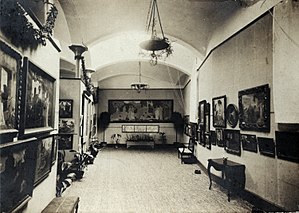
Another view of the gallery
Torres-García traveled to Brussels to paint a pavilion at the Brussels International World Off-white. During a prolonged stay in Paris, he visited friends, museums and galleries. Torres-García's art afterward shared aspects of cubism and the theories exemplified in Du "Cubisme" (published in 1912), indicated past the 1912 Paris exhibition organized and named by the Section d'Or. During his first trip to Italy and Switzerland, Torres-García was exposed to futurism.
He exhibited the painting Philosophy X Musa at the sixth International Exhibition of Fine art in Barcelona in 1911, donating it to the Institut d'Estudis Catalans. "From the moment of its public appearance until today this work has been unanimously interpreted past the historiography equally the foundational reference of noucentisme."[ii] Torres-García then painted a second version of the painting, which is part of the drove of the Reina Sofia Museum in Madrid.
In 1912, 2 exhibitions were held at the Galeries Dalmau: Torres-García (works from his Noucentista menses) and Pablo Picasso, with drawings from his Bluish Period (February - March 1912).[sixteen] [17] [18] Torres-García published his first book, Notes sobre Fine art (Notes on Art), in May 1913. In the introduction, he wrote: "Aquestes curtes notes poden tenir interès, demes, per anar estretament lligades, com quelcom de viu, a tot o que arrencant de la nostra tradició, en el pensament i en la realitat, tendeix a formar el ver Renaixement e Catalunya" ("These short essays may be of interest also considering they are closely related to, something that is alive, sprung from our tradition, in thought and in reality, to class the true Renaissance of Catalonia"). Torres-García then founded the Escuela de Decoración (School of Decoration/Decorative Arts) in Sarrià. "Prat de la Riba (president of the Council) had then his newly formulated conception of Catalan nationalism, and sees in the Mediterranean tradition proposed a positive content for the national profile, rich in spiritual substance."[19]
Prat de la Riba commissioned Torres-García frescoes for the atrium of the Municipal Palace of Barcelona, a 15th-century Gothic palace and seat of authorities in Catalonia.[20] During the side by side five years, he painted four large frescoes and studies for another two. The paintings became the new symbol of the Catalonia noucentista.[21] "In 1 of the frescoes ... Torres-Garcia represented a gigantic Pan-god with a quote from Goethe'due south 'Faust' at his feet: 'The temporal is only a symbol'. 'That is the central to all the poetics of Torres-García, the volition to surrender to the ephemeral in social club to attain eternity,' explained Llorens. For Torres-García, classicism was the door of a better future, not a restriction for modernity."[22] Torres-García used iconostatic composition for pagan subjects adapted to modern themes, demonstrating that classicism is not unique to the Greeks. He painted the rhythm of a structure, equally he described in "El Descubrimiento de si mismo" and "Evolucionista" (both published in 1917). Torres-García later used the same composition in his constructivist works. He designed, congenital, and decorated his domicile in Tarrasa ("Mon Repos") with frescoes, and invited friends and pupils to a housewarming party.[23]
In 1918, "Torres-García can be seen exploring the grid construction,' on the one hand every bit an inherent characteristic of a modern urban center and on the other as a form to explore the symbolic potential of everyday motifs. He also explored the potential for linguistic communication inside images, as in the 1916–17 drawing 'Descubrimiento de si mismo (Discovery of Oneself)."[24] He presented an exhibition at Galeries Dalmau of "Joguines d'Fine art (Artistic Toys)": "The toys teach children which are the correct colors, the correct forms. Each toy is a form, a color that mixes with other shapes and colors and finally becomes a whole: a dog, a car, a urban center. The toys guide future generations to acquire a natural eye."[25]
In 1919, Torres-García visited the United States: "He determined to take the pulse of the greatest and most modern of cities, New York."[half dozen] "Despite being i of the nigh important artists of the moment, Torres García did not lull, and in 1920 he went to New York to continue exploring what they called modernity and began to cling to the imperceptible and temporal, what he drew in the city of skyscrapers connects with what John Dos Passos reflected in Manhattan Transfer."[26]
1920–1929 [edit]
Torres-García visited Paris for a 2d time with thirty-2 crates of paintings after an come across with his friend Picasso, who brash him to remain there: "Practice not to go to America, because it will be like leaping into a void". His piece of work evolved from classicism to Cubism, as Picasso's work did the contrary.[27] Wanting to experience a mod city, Torres-García traveled to New York with the intention of staying for two years. He lived in Manhattan: commencement on 49th Street, then on 14th Street and finally on West 29th Street. Torres-García continued his series of sketchbooks of the cities he visited, reflecting the city's movement and temper. He painted a serial of portraits, including 1 of Joseph Stella. Torres-García depicted Broadway's cityscape and people. He exhibited at the Whitney Studio gallery[28] and the Society of Independent Artists with Stuart Davis and Stanisław Szukalski in 1922, describing his piece of work as "expressionistic and geometric at the same time, and very dynamic".[29]
Torres-García returned to Italy that year, developing his classic and evolutionistic works. Spain banned the Catalan language, including his writings. During this menstruation, Torres-García'due south mother died. He settled in Villefranche-sur-Mer in 1925, and had another solo exhibition at Galeries Dalmau in Barcelona the post-obit year.[30]
Torres-García returned to Paris for the third fourth dimension in 1926,[27] [31] and was a key animator of the interwar abstract movement over the next six years.[ii] He exhibited 34 works, a series of big, classical nudes, and paintings from New York at the Galerie A. 1000. Fabre. "40 works make up this presentation of Torres-Garcia first exhibit here at Galerie Fabre: frescoes, fragments of large murals, assembled architectural maquettes, still life or figures ... They show the artist under different aspects manifesting all the fiery wealth and complex diversity. Some urban landscapes will give an idea of the passage of Torres-Garcia by New York were a feverish spectacle of the business organization urban center captivated some time his artistic inquietude in search of its rhythm. Although he has played a major role in the development of the Mediterranean schoolhouse, Garcia is bent with such a strength towards his personal inclination he has always cleared away from the prejudices of isms (schools) that might limit his personal growth."[32] "Yet, by returning to the Classicism of his early work he made it articulate that this was not an artistic language he had sought to vanquish through abstraction".[24] Torres-García was part of a May 1927 group bear witness with Stanislaw Eleszkievicz and Runser at the Galerie d'art du Montparnasse, and had a solo exhibition of paintings at the Galerie Carmine from 16 to 30 June 1927.[33]
He had a solo exhibition at the Galerie Zak in December 1928, and was part of a grouping exhibition at the Galerie des Editions Bonaparte with John Graham, Kakabadze, Tutundjian, and Vantongerloo in August 1929. Torres-García and so had another solo exhibition at the Galerie Carmine. As a correspondent for the Catalan literary magazine Mirador he wrote a series of articles on painters, including an interview with Georges Braque. "Only if Mondrian wanted to explore modernity by a unmarried path, he (Torres-García) wanted to get to the bottom by two paths at the same time, starting from reason but not avoiding intuition".[26]
1930–1939 [edit]
Admission to constructivism may accept converted Torres-García to neoplasticism in Paris,[34] and he balanced representation and abstraction with signs.[34] He had two solo exhibitions in 1931 at the Galerie Jeanne Bucher and the Galerie Percier, and a grouping bear witness in October of that twelvemonth at the Galerie Georges Petit with Giacometti, Ozenfant, Max Ernst, Miro, and Salvador Dalí.[35] The following year, Torres-García presentd a solo exhibition of paintings and sculptures at the Galerie Pierre. "The friendship between van Doesburg and Torres-Garcia will create the foundations for the three most important movements to promote abstract fine art: "Cercle et Carre" (1929–1930), "Art Concret" (1930); and "Abstraction-Creation"(1931–1936)."[ii] He founded the magazine Cercle et Carre with van Doesburg, and assembled a group of eighty artists.[seven] Torres-García left for the Community of Madrid and finished the manuscript of Arte Constructivo, which was published in 1935 under the proper noun of "Estructura" and dedicated to his friend Piet Mondrian.
He returned to Montevideo in April 1934 for the first time since childhood. In August of that twelvemonth, Torres-García exhibited paintings, sculptures and the work of the Cercle et Carre group and reedited the mag equally Circulo y Cuadrado.[27] He published Historia de mi vida (Story of My Life) an autobiographical novel, in 1937. Two years later, Torres-García began work on the pink-granite Monumento Cosmico, a representative work from this period.[27]
1940–1949 [edit]
Torres-García announced the closing of the Association of Effective Arte schoolhouse in the final of 500 lectures he gave betwixt 1934 and 1940. In 1941, he published Ciudad sin Nombre (A City With No Name). Torres-García presented a solo exhibition at the Society of Architects of Uruguay in November of that year. In July 1942, he received a visit from Comity of Inter-American Relations curator Lincoln Kirsten and Nelson A. Rockefeller.[27] Torres-García founded the Taller Torres Garcia, similar to the European Bauhaus, two years later; the schoolhouse included future artists Olga Piria, Gonzalo Fonseca, José Gurvich, Alceu Ribeiro, Julio Alpuy, Lily Salvo and his sons, Horacio and Augusto. Torres-García returned to the maternity theme from his 1914 Barcelona mural that twelvemonth, creating a mural for the Sindicato Médico del Uruguay; he also painted seven monumental mural frescoes for the Hospital Saint Bois tuberculosis sanitarium. Torres-García died on viii August 1949 while preparing two exhibitions: one at the Sidney Janis Gallery in New York and other at the Pan American Union in Washington.
Influences and legacy [edit]
Influenced by European, North American and South American modern fine art,[36] his work evolved into a more abstract construction; Picasso, seven years younger, was a follower.[36] Joan Miró was a student of Torres-García in Barcelona who best-selling his instructor's influence,[31] [37] and Torres-García'southward constructive paintings influenced the evolution of Latin American geometric abstraction.[38]
Works [edit]
Mon Repos frescoes (1914) [edit]
Palau de la Generalitat (1913-1917) [edit]
The Joaquín Torres-García Hall in the Palace of the Generalitat of Catalonia houses the frescoes painted by the creative person on the walls of Salon Sant Jordi from 1912 to 1916, commissioned by President of the Council and the Commonwealth of Catalonia Enric Prat de la Riba. Torres-García worked on the first mural for 13 days, beginning on 28 July 1912, and it was unveiled on thirteen September of that twelvemonth.[6] The iv completed frescoes are entitled La Catalunya Eterna (Catalunya Eternal), Fifty'Etat d'Or (The Aureate Historic period), Les Muses (The Muses) and Lo temporal no es mes que simbol (The Temporal is Nothing Just a Symbol). The murals were hidden from 1926 to 1966.[ citation needed ]
Paintings (1918-1943) [edit]
-

Poemes en ondes hertzianes
-

-

Linòleum
-

Bodegom
-
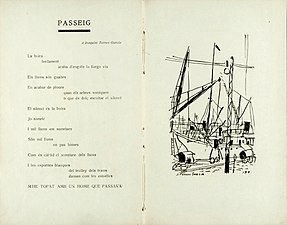
Passeig
-

Interior-Salvat
-
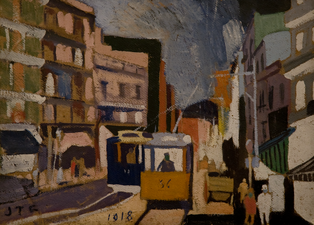
Paisaje de ciudad
-
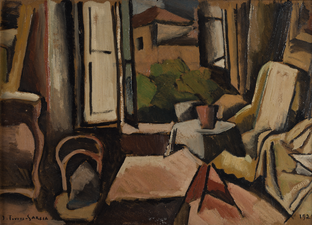
Interior
-
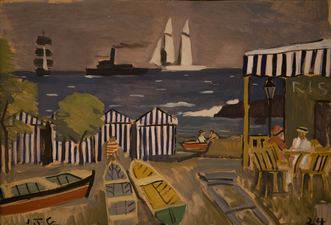
Paisaje de playa
-

Figuras
-

Pintura
-

Pintura constructiva 5
-

Figuras sobre uma estrutura (1930)
-

Contraste
-

Pintura constructiva 2
-

-
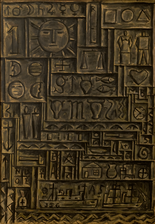
Arte universal
-
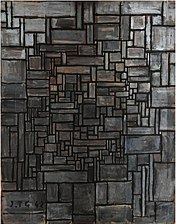
Arte constructivo
Monumento Cosmico (1938) [edit]
Selected writings [edit]
- Augusta et Augusta, Barcelona, Universitat Catalana, 1904
- Dibujo educativo en el colegio Mont D'Or, Barcelona, 1907
- Notes sobre Art, Barcelona, 1913
- Diàlegs, 1914
- Descubrimiento de sí mismo, 1914
- Consells als artistes, Barcelona, Un enemic del poble, 1917
- Em digué tot aixó, Barcelona, La Revista, 1917
- D'altra orbita, Barcelona, Un enemic del poble, 1917
- Devem Caminar, Barcelona, Un enemic del poble, 1917
- Art-Evolució, Barcelona, Un enemic del poble, 1917
- El Públic i les noves tendéncies d'art, Barcelona, Velli nou, 1918
- Plasticisme, Barcelona, Un Enemic del poble, 1918
- Natura i Fine art, Barcelona, Un Enemic del poble, 1918
- 50'Art en relació al dwelling house etern i l'home que passa, Sitges, Imprenta El eco de Sitges. 1919
- La Regeneració de si mateix, Barcelona, Salvat Papasseit Editor, 1919
- Poemes en ondes hertzianes, 1919 (illustrator)
- Foi, París, 1930
- Ce que je sais, et ce que je fais par moi-même, Losones, Suiza, 1930
- Pére soleil, París, Fundación Torres García, 1931
- Raison et nature, Ediciones Imán, París, 1932
- Estructura, Montevideo, 1935
- De la tradición andina: Arte precolombino, Montevideo, Círculo y cuadrado, 1936
- Manifiesto 2: Constructivo 100 %, Montevideo, Asociación de Arte Constructivo, 1938
- La tradición del hombre abstracto (Doctrina constructivista). Montevideo, 1938
- Historia de mi vida. Montevideo, 1939
- Metafísica de la prehistoria indoamericana, Montevideo, Asociación de Arte Constructivo, 1939
- Manifiesto iii, Montevideo, Asociación de Arte Constructivo, 1940
- La ciudad sin nombre. Montevideo, Uruguay, Asociación de Arte Constructivo, 1942
- Universalismo Constructivo, Montevideo, 1944
- Con respecto a una futura creación literaria y dos poemas, Divertimento i y Divertimento 11, Montevideo, Revista Arturo, 1944
- La decoración mural del pabellón Martirené de la colonia Saint Bois. Montevideo, Gráficas Sur, 1944
- En defensa de las expressiones modernas del arte, Montevideo, 1944
- Nueva escuela de arte de Uruguay. Montevideo, Asociación de Arte Constructivo, 1946
- La regla abstracta. Montevideo, Asociación de Arte Constructivo, 1946
- Mística de la pintura, Montevideo, 1947
- Lo aparente y lo concreto en el arte, Montevideo, 1948
- La recuperación del objeto, Montevideo, 1948
Selected paintings [edit]
- La colada, oil on canvas, 1903
- La casa del lavadero, oil on canvas on wood, 1903, Museo Abadía de Montserrat, Barcelona
- El pintor con su familia 1917
- Construction in White and Black at the Museum of Modernistic Art (1938)
- Constructive Metropolis with Universal Man
- Limerick
Major exhibitions [edit]
- 25 Oct 2015 – 15 February 2016, Joaquín Torres-García: the Arcadian modern, Museum of Modernistic Art, New York
- 29 December 2013 – ii March 2014, Art & Textiles: cloth as textile and concept in modern art from Klimt to the present, Kunstmuseum Wolfsburg, Germany
- 22 Apr 2013 – 30 Jun 2013, From Picasso to Barceló: Spanish Sculpture of the 20th Century, National Fine art Museum of China
- 16 May – 11 September 2011, Torres-García a les seves cruïlles (Torres-García at his Crossroads), Museu Nacional d'Fine art de Catalunya (MNAC), Barcelona
- 27 March 2009, Trazos de Nueva York, Museo Torres-Garcia, Montevideo
- December, 2008 - Apr 2009, Torres García a Vieira da Silva, 1929–1949, IVAM, Valencia, Museu Colecção Berardo, Portugal
- 8 Oct 2005 – 15 Feb 2006, Le feu sous les cendres : de Picasso à Basquiat, Fondation Dina Vierny-Musée Maillol, Paris
- 7 October 2005 – 19 Feb 2006, Obras maestras del siglo 20 en las colecciones del IVAM, Valencia
- 25 November 2003 – 11 Apr 2004, Torres-Garcia, Museu Picasso, Barcelona
- 2003, Jean-Michel Basquiat-Gaston Chaissac-Jean Dubuffet-Joaquin Torres-Garcia, Jan Krugier Gallery, New York
- September 2002, From Puvis De Chavannes to Matisse and Picasso : Toward Modern Fine art, Palazzo Grassi, Venice
- 24 May – eight September 2002, Joaquin Torres-Garcia : un monde construit : Musée d'fine art moderne et contemporain, Strasbourg
- 31 May – 23 Baronial 1992 Joaquin Torres-Garcia en Theo van Doesburg, The Stedelijk Museum, Amsterdam
Bibliography [edit]
- Joaquim Torres i García; Estherde Cáceres, Carmelo de Arzadum, Alfredo Cáceres, Pablo Purriel, Juan R. Menchaca, i Guido Castillo, the ornament mural of the Martirené pavilion of the colony Saint Bois. Murals paintings of pavilion J.J. Martirené Infirmary of the colony Saint Bois. Southward graphs. Montevideo, 1944.
- Claude Schaefer, Joaquin Torres García. Ed. Poseidón. Library Argentina de Arte. Buenos Aires, 1949.
- Josep Francesc Ràfols, Biographical Dictionary of artists of Catalonia. Torres-Garcia, Joaquin, Volume III, p. 153. Barcelona, Milà, 1966.
- Daniel Robbins, Joaquin Torrers-Garcia, 1874–1949. Ed. by Museum of Art Rhode Island School of Design. Providence, 1970. ISBN 0-911517-23-5
- Enric Jardí, Torres García. Editorial Polígrafa, Due south. A., Balmes, 54 – 08007, Barcelona, 1973. ISBN 84-343-0180-6
- Jacques Lassaigne, Ángel Kalenberg, Maria Helena Vieira da Silva, Michel Seuphor, Jean Hélion, Torres-Garcia. Structure et Symbols. Published by the Museum of Mod Fine art of Villa of Paris. Catalogue of the exhibition made between June and August 1975. Paris, 1975.
- Jacques Lassaigne, Torres-Garcia. Works destroyed in the burn down of the museum of modern art of Rio de Janeiro, Published by the Torres Foundation Garci'a. Montevideo, Uruguay. 1981.
- Margit Rowell, Theo van Doesburg, Joaquín Torres-García, Torres Garcia Structure. Paris-Montevideo 1924–1944 Edited by Foundation Joan Miró. Catalogue of the exhibition in the Fundació Joan Miró, Parc de Montjuic in March 1986. Barcelona, 1986.
- Ángel Kalenberg, Seis Maestros De La Pintura Uruguaya: Juan Manuel Blanes, Carlos Federico Saez, Pedro Figari, Joaquin Torres García, Rafael Barradas y José Cúneo. Edited by Museo Nacional de Bellas Artes de Buenos Aires. Catálogo de la exposición realizada entre Septiembre y Octubre de 1987. Avda. del Libertador, 1473. Buenos Aires, 1987. Montevideo, 1987.
- Alicia Haber, Joaquin Torres Garci'a. Eternal Catalonia. Sketches and drawings for the fresh airs of the Delegation of Barcelona. Edited by Foundation Torres García. Montevideo, 1988.
- María Jesús García Puig, Joaquin Torres Garcia and the Effective Universalismo: The instruction of the art in Uruguay. Editions of Hispanic culture. Drove Art. Madrid, 1990. ISBN 84-7232-558-Ten
- Jorge Castle, Nicolette Gast, Eduardo Lipschutz-Villa, and Sebastián López, The antagonistic Link. Joaquin Torres Garcia-Theo van Doesburg. Published past Institute of Contemporary Fine art. Ámsterdam, 1991.
- Pilar Garcia-Sedas, Joaquin Torres the Striped Garcias and Rafael. Dialeg escrit: 1918–1928. Publicacions of 50' Abbey of Montserrat. Barcelona, 1994. ISBN 84-7826-531-7
- Joan Sureda Pons, Narcís [Narciso], Comadira and Mercedes Doñate, Torres Garcia: Pintures de Monday Repos, Published by the Museum of modern Art of the Museum of Art of Catalunya and the Caixa of Terrassa. I catalogue of the exhibition that place in the museum of modern art of the MNAC took, and in the Cultural Foundation of the Caixa of Terrassa. Barcelona, January 1995.
- Pilar García-Sedas, Joaquim Torres Garcia. Epistolari Català: 1909–1936. Curial Edicions Catalan. Publicacions of l' Abbey of Montserrat, Barcelona, 1997. ISBN 84-7826-839-1
- Joan Sureda Pons, Torres Garcia. Archetype passion. Akal editions/contemporary Fine art. Number v. Madrid, 1998. ISBN 84-460-0814-9
- Carlos Pérez, Pilar Garcia-Sedas, Mario H. Gradowczyk and Emilio Ellena, Aladdin Toys. Them joguines of Torres Garcia. Published by the IVAM. I catalogue of the exhibition that took place in the Valencian Institute of Modernistic Art in September 1998.
- Miguel Angel Battegazzore, the plot and the signs, Impresora Gordon, Due south.A. Av. General Rondeau 2485, Montevideo, 1999.
- Gabriel Peluffo Linari, History of the Uruguayan painting. Editions of Eastern band express liability company. Gaboto 1582. Montevideo 11200. Uruguay, 1999 imaginary Tomo the one National-regional (1830–1930) from Blanes to Figari Tomo 2 Betwixt localismo and universalismo: Representations of modernity (1930–1960).
- Michael Peppiatt, Jean-Michel Basquiat - Gaston Chaissac - Jean Dubuffet - Joaquin Torres-Garcia, New York, catalogue of the exhibition that took place in Jan Krugier Gallery, 2003.
- Tomàs Llorens, Emmanuel Guigon, J.Torres-Garcia Un monde construit, Hazan, Strasbourg, 2002, catalogue of the exhibition that took place in Musée d'Art Moderne et Contemporain de Strasbourg, 24 May to September 2002.ISBN 2-85025-827-Ten
- Tomàs Llorens, Emmanuel Guigon, Juan José Lahuerta, J. Torres-Garcia, Editorial Ausa y Institut de Cultura de Barcelona, Barcelona, 2003, catalogue of the exhibition that took identify in Museo Picasso de Barcelona, 25 November to eleven April 2004.ISBN 84-88810-63-6
- Nicolás Arocena Armas, Eric Corne, Marina Bairrão, Emmanuel Guigon, Domitille D'Orgeval, La ituicion y la Estructura, Lisboa, Museo Coleccao Berardo, 2008.ISBN 978-84-482-5105-5
- Tomás Llorens, Nicolás Arocena Armas, Torres-Garcia a les seves cruilles-Torres-Garcia en sus encrucijadas. Barcelona, Spain: Museu Nacional d'Art de Catalunya 2011.
- Llorens, Tomas. Arocena Armas, Nicolas, J.Torres-Garcia, New York, Joaquin Torres-Garcia Archive, 2011. Notes
Notes [edit]
- ^ a b Roca, Alfons (2012). El Palau de la Generalitat de Catalunya Resum de 600 anys d'art. Barcelona: Generalitat de Catalunya. p. 22.
- ^ a b c d Llorens, Tomàs (May 2011). Torres-Garcia a les seves cruilles-Torres-Garcia en sus encrucijadas. Barcelona, Spain: Museu Nacional d'Art de Catalunya. p. 18. ISBN978-84-8043-232-0.
- ^ Coll Tomas, Baltasar (1977). Catedral de Mallorca. Palma de Mallorca: Museo Capitular. p. 43. ISBN84-400-3133-5.
- ^ Torres-Garcia, Joaquin (1939). Historia de mi vida. Montevideo: Publicaciones de la Asociacion de Arte Constructivo. p. 95.
- ^ "El Palau de la Generalitat, seu de la Presidència, Sala 16, Sala de Torres-Garcia". Generalitat de Catalunya. Archived from the original on 24 September 2015.
- ^ a b c d Robbins, Daniel (1970). Joaquin Torres-Garcia 1874–1949. Providence: Museum of Art, Rhode Island School of Pattern.
- ^ a b Schaefer, Claude (1949). Joaquin Torres-Garcia. Buenos Aires: Editorial Poseidon.
- ^ Doyle Duncan, Barbara (1971). Joaquin Torres-Garcia. 1: University of Texas.
{{cite book}}: CS1 maint: location (link) - ^ Surio, Dario (1965). Torres-Garcia Memorial Exhibition. New York: Rose Fried Gallery.
- ^ Llorens, Tomas (2011). J. Torres-Garcia. New York: Joaquin Torres-Garcia Archive.
- ^ Utrillo, Miguel. "Joaquin Torres-Garcia, Decorator". Pèl i Ploma No. 74
- ^ Armas Arocena, Nicolas (2008). Torres-Garcia Pythagoras – Plato: A Geometric Dialogue, or The Eye of the Soul. Lisbon: Museo Coleccao Berardo. ISBN978-84-482-5105-five.
- ^ Sureda Pons, Joan (1998). Torres-Garcia, Pasion Clasica. Madrid: Ediciones Akal.
- ^ "EVA DIAZ TORRES - Museo Torres García". 23 June 2016. Archived from the original on 23 June 2016. Retrieved 21 March 2022.
- ^ Cruz, Pedro da (1994). Torres García and Cercle Et Carré: The Creation of Constructive Universalism : Paris 1927-1932. Lund Academy. ISBN978-91-628-1276-8.
- ^ Josep Palau i Fabre, Picasso a Catalunya, Edicions Polígrafa, S.A., Barcelona, 1975, p. 196
- ^ Exposició de dibuixos i pintures de Joaquim Torres García, Galeries Dalmau, 1912 (exhibition catalogue)
- ^ Picasso, Veu de Catalunya, 7 March 1912
- ^ Marquina, Eduardo (1933). J. Torres-Garcia. Madrid. p. 4.
- ^ Wheeler, Monroe (1971). Joaquin Torres-Garcia. University Art Museum University of Texas at Austin. p. 3.
- ^ Roca, Alfons (2012). El Palau de la Generalitat de Catalunya Resum de 600 anys d'art (PDF). Barcelona: Generalitat de Catalunya. p. 22. Archived from the original (PDF) on 6 Oct 2015.
- ^ Penelo, Lidia (17 May 2011). "Las encrucijadas de Torres-García llegan al MNAC". Publico.
- ^ Woodcut invitation by artist dated 1915. ill. Eric Jardi 1973
- ^ a b Roe, Jeremy (2011). "Creative Forks". Apollo.
- ^ Molins, Javier (2003). Grandes Artistas: La mirada de los descendientes. Valencia: IVAM Institut Valencia d'Fine art Modernistic. p. 56. ISBN84-482-3564-9.
- ^ a b Lidia Penelo. "Las encrucijadas de Torres-García llegan al MNAC". publico.es . Retrieved 29 September 2017.
- ^ a b c d east Arocena Armas, Nicolas (2011). Torres-Garcia a les seves cruilles-Torres-Garcia en sus encrucijadas. Barcelona: Museu Nacional d'Art de Catalunya. p. 232. ISBN978-84-8043-232-0.
- ^ Annual exhibition of painting and sculpture past members of the Club, New York, Northward.Y., Whitney Studio Club, 1922
- ^ "Joaquín Torres-García (1874–1949) Ane Human, 3 Continents". Joaquín Torres-García Archive . Retrieved v Oct 2015.
- ^ Catàleg de l'Exposició de Joaquim Torres García, organitzada a les Galeries Dalmau del Passeig de Gràcia, del 12 al 25 de juny 1926 Barcelona
- ^ a b "The Worlds of Joaquín Torres-García". Wall Street International. 10 April 2018. Retrieved 14 May 2020.
- ^ Juan de Gary. Mai 1926 Excerpt from the catalog of the exhibition at Galeri A.G. Fabre twenty Rue de Miromesnil du seven au xx de Juin 1926. Translated from French
- ^ Catàleg de l'Exposició de Joaquim Torres García, organitzada a la Galerie Carmine, del 16 al 30 de juny. París. Pròleg de Joseph Milbauer
- ^ a b Llorens, Tomas (2003). Torres-Garcia. Editorial Ausa. p. 255. ISBN84-88810-63-half-dozen.
- ^ "Expositions". Camaraderie Français. fifteen November 1931.
- ^ a b Tomas Llorens; Abigail McEwan; Frederic Tuten. The Worlds of Joaquin Torres-Garcia.
- ^ Market, The Editors of Art. "The Worlds of Joaquín Torres-García". Retrieved 14 May 2020.
- ^ Clifford, Benjamin (1 May 2018). "The Worlds of Joaquín Torres-García". The Brooklyn Rail . Retrieved 14 May 2020.
References [edit]
- Arocena Armas, Nicolas. Torres-Garcia- Pythagoras- Plato A Geometric Dialogue, or the Eye of the Soul, Lisboa, Museo Coleccao Berardo, 2008
- Arocena Armas, Nicolas. Biography. Torres-Garcia a les seves cruilles-Torres-Garcia en sus encrucijadas. Barcelona, Spain: Museu Nacional d'Art de Catalunya 2011.
- Llorens, Tomas.Torres-Garcia a les seves cruilles-Torres-Garcia en sus encrucijadas. Barcelona, Spain: Museu Nacional d'Art de Catalunya 2011
- Llorens, Tomas. J.Torres-Garcia, New York, Joaquin Torres-Garcia Archive, 2011.
- Llorens,Tomas. Torres-Garcia. Editorial Ausa, 2003
- Robbins, Daniel. Joaquin Torres-Garcia 1874–1949. Providence, Museum of Art Rhode Island School of Design, 1970
- Rafols, F. Josep, Torres-Garcia, Barcelano, 1926.
- Schaefer, Claude. Joaquin Torres-Garcia. Buenos Aires, Editorial Poseidon, 1949.
- Sureda Pons, Joan. Torres-Garcia, Pasion Clasica. Madrid, Ediciones Akal, 1998
- Surio, Dario. Torres-Garcia. Rose Fried Gallery, New York, 1965
- Torres-Garcia, Joaquin. Historia de mi vida. Montevideo, Ediciones Asociacion Arte Constructivo, 1939.
External links [edit]
- Archive Joaquin Torres-Garcia
- http://www.philamuseum.org
- National Gallery of Art
- http://www.guggenheim.org
- Museo Centro de Arte Reina Sofia
- Museo Thyssen-Bornemisza
- Albright-Knox Art Gallery
- Rhode Isle School of Design Museum
- Smithsonian Archives of American Art
- Museo Torres García – Montevideo
- LACMA
- Joaquin Torres Garcia, Museum of Modern Fine art
- Metropolitan Museum of Art
- http://www.musee-lam.fr/
Source: https://en.wikipedia.org/wiki/Joaqu%C3%ADn_Torres-Garc%C3%ADa





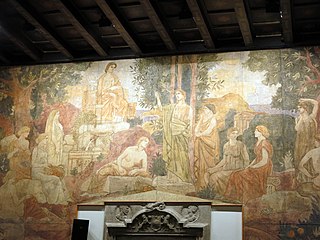




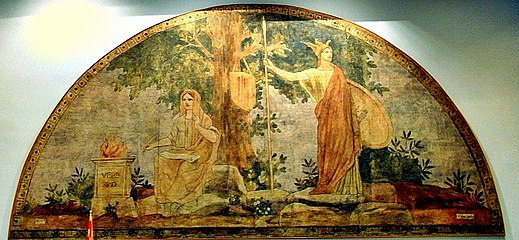


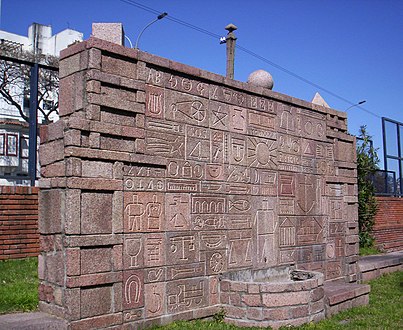
0 Response to "Joaquin Torres Garcia Nuevo Arte De Las Americas 1942"
Post a Comment